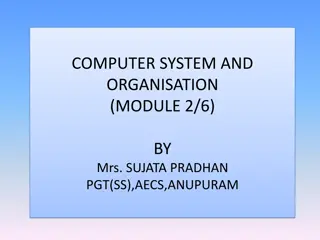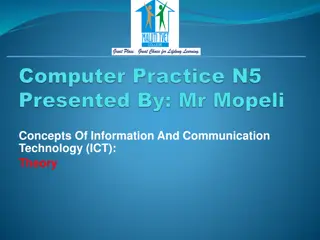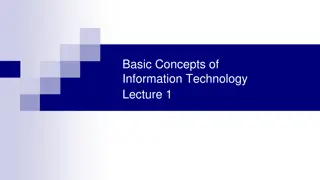Evolution of Computers: Generations Overview
The evolution of computers through generations - from vacuum tubes and magnetic drums in the first generation to transistors and integrated circuits in later generations. Each phase brought advancements in size, speed, and efficiency, shaping the modern computing landscape.
Download Presentation

Please find below an Image/Link to download the presentation.
The content on the website is provided AS IS for your information and personal use only. It may not be sold, licensed, or shared on other websites without obtaining consent from the author.If you encounter any issues during the download, it is possible that the publisher has removed the file from their server.
You are allowed to download the files provided on this website for personal or commercial use, subject to the condition that they are used lawfully. All files are the property of their respective owners.
The content on the website is provided AS IS for your information and personal use only. It may not be sold, licensed, or shared on other websites without obtaining consent from the author.
E N D
Presentation Transcript
COMPUTER FUNDAMENTALS GENERATIONS OF COMPUTER
Generations Of Computer First Generation Second Generation Third Generation Fourth Generation Fifth Generation
First Generation(1940-1956) The first computer systems used vacuum tubes for circuitry and magnetic drums for main memory , and they were often enormous, taking up entire rooms. These computers were very expensive to operate, and in addition to using a great deal of electricity, the first computers generated a lot of heat, which was often the cause of malfunctions. The maximum internal storage capacity was 20,000 characters.
First-generation computers relied on machine language , the lowest-level programming language understood by computers, to perform operations, and they could only solve one problem at a time. It would take operators days or even weeks to set up a new problem. Input was based on punched cards and paper tape, and output was displayed on printouts. It was in this generation that the Von Neumann architecture was introduced, which displays the design architecture of an electronic digital computer. Later, the UNIVAC and ENIAC computers, invented by J. Presper Eckert, became examples of first-generation computer technology. The UNIVAC was the first commercial computer delivered to a business client, the U.S. Census Bureau in 1951.
Second Generation(1956-1963) The world would see transistors replace vacuum tubes in the second generation of computers. The transistor was invented at Bell Labs in 1947 but did not see widespread use in computers until the late 1950s. This generation of computers also included hardware advances like magnetic core memory, magnetic tape, and the magnetic disk.
In Second Generation The transistor was far superior to the vacuum tube, allowing computers to become smaller, faster, cheaper, more energy-efficient, and more reliable than their first- generation predecessors. Though the transistor still generated a great deal of heat that subjected the computer to damage, it was a vast improvement over the vacuum tube. A second-generation computer still relied on punched cards for input and printouts for output.
Third Generation(1964-1971) The development of the integrated circuit was the hallmark of the third generation of computers. Transistors were miniaturized and placed on silicon chips, called semiconductors, which drastically increased the speed and efficiency of computers. Instead of punched cards and printouts, users would interact with a third-generation computer through keyboards, monitors, and interfaces with an operating system, which allowed the device to run many different applications at one time with a central program that monitored the memory. Computers, for the first time, became accessible to a mass audience because they were smaller and cheaper than their predecessors.
Fourth Generation(1971-PRESENT) The microprocessor ushered in the fourth generation of computers, as thousands of integrated circuits were built onto a single silicon chip. The technology in the first generation that filled an entire room could now fit in the palm of the hand. The Intel 4004 chip, developed in 1971, integrated all the components of the computer, from the central processing unit and memory to input/output controls, on a single chip. In 1981, IBM introduced its first personal computer for the home user, and in 1984 Apple introduced the Macintosh. Microprocessors also moved out of the realm of desktop computers and into many areas of life as more and more everyday products began to use the microprocessor chip.
Fifth Generation(PRESENT and BEYOND) Fifth-generation computer technology, based on artificial intelligence, is still in development, though there are some applications, such as voice recognition, that are being used today. The use of parallel processing and superconductors is helping to make artificial intelligence a reality. This is also so far the prime generation for packing a large amount of storage into a compact and portable device. Quantum computation and molecular and nanotechnology will radically change the face of computers in years to come. The goal of fifth- generation computing is to develop devices that will respond to natural language input and are capable of learning and self-organization.























